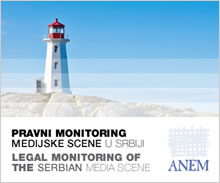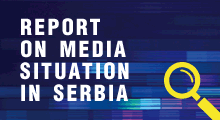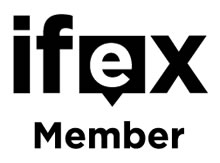02. 02. 2015
IMPLEMENTATION OF NEW MEDIA LAWS – SECOND ANEM SEMINAR
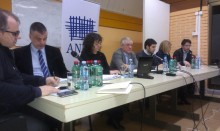
The panelists presented key changes in the media regulatory framework and pointed to further steps in the implementation of the set of media laws. The seminar gathered almost 60 participants from media, local self-governments and other interested parties.
The event was opened by Milorad Tadic, ANEM president, and Ljiljana Breberina, representative of the Media Department of the OSCE Mission to Serbia. The panelists were: Sasa Mirkovic, state secretary at the Ministry of Culture and Information; Slobodan Kremenjak, attorney at law and member of the ANEM legal team; Slavica Tanasijevic of the Privatization Center with the Privatization Agency; Rajka Galin Certic, assistant director for legal affairs, Regulatory Body for Electronic Media; Rade Veljanovski, professor at the Faculty of Political Sciences, University of Belgrade; and Milos Stojkovic, member of the ANEM legal team.
The aim of the seminar was to contribute to better understanding of media laws and to point media representatives and other interested parties to proper implementation of the media laws. Another four seminars on the implementation of new media laws will be held by ANEM in 2015 - in Kragujevac, Subotica, Nis and Novi Pazar.
Slobodan Kremenjak spoke about novelties in the media laws. He began by saying that there is a general opinion in the media community that media laws always stress obligations of media workers, while their rights are neglected. However, such approach is not the most adequate since Serbia, already in 2003, ratified the European Convention Convention for the Protection of Human Rights and Fundamental Freedoms, and the Consitution of 2006 envisages direct application of international conventions' provisions pertaining to human rights, in accordance with the practice of bodies competent for the implementation thereof. This means that Serbia has had Article 10 of the European Convention as an element of its internal legal system since then. Therefore, state bodies, including courts, have had the obligation to apply these rules in accordance with the practice of the bodies competent for monitoring the implementation of the rules - in our case the European Court of Human Rights. Hence, the setting for implementing the rules of international conventions has been in place since the adoption of the new Constitution.
However, the practice was different. Still, the errors were those of the implementation, not of the legal framework. Thus the aim of the new media laws was not to significatnly change these rules, but to try tro ammend them so as to improve their application. Therefore, the following amendments were introduced: the provisions regulating which information concerning a criminal proceedings may be publicized were defined more precisely; provisions on joint liability in cases where the same information is published by two media were clarified (the provisions of the new law explicitly exclude the possibility of joint liability of a journalist, editor-in-chief and publisher of one media outlet with those of another, which prevents some cases that have been occuring in practice - for instance, the case of the daily „Danas", which daily was held responsible for an article originally published by a different media outlet, under the notion of joint liability envisaged by the old law); basis for exemptions from responsibility are more clearly defined (which is particularly important when quoting police documents); new criteria for establishing compensatory damages were set, i.e. the amount of compensation depends on whether „other means of legal protection" were previously used (a correction or a reply).
Among the novelties that the new laws bring is a change to the definition of media. Media is now determined as means to convey "editorially shaped information", which definition was absent from the previous law where media was treated exclusively as a means of public distribution of information to an indefinite number of users. The new definition is important for differentiating social networks and other means of Internet-based communication from traditional media. According to the Law on Public Information and Media, a traditional medium is always a medium, and its Internet edition is a medium, too. All other channels of communication are free to register as media or not. Social networks, forms and similar channels of communication are not media because they are based on "user generated content" and not on "editorially generated content". Therefore, the regulation of these communication channels is subject to acts regulating e-business and information society services, rather than media laws.
The other important novelty is redefining of the rules on founder, as now a natural person (entrepreneur) may be a media publisher. Limitations regarding publishers are clear and they pertain to state-owned media. Namely, according to the Law on Public Information and Media, media publishers may no longer be public entities, save for precisely listed exceptions: two public service broadcasters (RTV and RTS), the institution established in order to exercise the right to public information of the population living on the territory of the Autonomous Province of Kosovo and Metochy (so far it was RTV Panorama) and the entities (institutions, foundations or companies) established by National Minority Councils that become media publishers. The third novelty concerns the provisions stipulating that the right to publish media is subject to legal transaction.
The Law on Public Information and Media introduces entirely new rules on state aid. The novelty is logical considering that a lot has changed since 2003, when the old Law on Public Information was adopted. In 2009 the Law on State Aid Control was adopted, which law defines state aid as any real or potential public expenditure or diminished public income that secures to a state aid benficiary a more favorable position in the market relative to its competitors, which distorts or threatens to distort competition in the market. Therefore, state aid as such is generally forbidden and may be used only exceptionally. On the one hand, the new laws attempted to harmonize media rules with the general framework for the control of state aid, and on the other - to answer numerous objections (coming from privately-owned media) stressing the lack of free competition due to the existence of publicly-owned media and privately-owned media receiving subsidies from public authorities without clearly defined rules. It is because of this that the new Law introduces these rules, prescribed in the part on the project-based funding. A project must be related to realizing public interest in the public information sector (public interest is defined by the Media Strategy and now by the Law).
Another important change are the provisions on the Media Register, particularly concerning transparency of media ownership, the amount of state aid and other information important for informing citizens. Failure to enter information in the Media Register results in the ban on competing for project-based funding and the ban on advertising by public entities in such media. It is important to note that such media are not prevented from operating - however, logical limitations of financial nature are introduced.
Saša Mirković presented the key activites of the Ministry for Culture and Information regarding the implementation of the new media laws since their entering into force on 13 August 2013. Mirkovic announced the issuing of the public competition for co-financing of projects for 2015 in the categories pertaining to fulfillment of public interest in accordance with the law. The Ministry will be receiving applications in February and it will invite journalists' and media associations to put forward their proposals for establishing expert panels for the assessment of project proposals in accordance with the law. Mirkovic explained the difference between project „financing" and „co-financing" given that the proper legal term is „project co-financing" since the public body allocates the project funds in the amount of 80% of project cost, and not 100%.
Since the adoption of the rulebooks on the co-financing of projects, on registering the media in the Media Register, and on keeping of the records and the entry in the records of international media representatives and representative offices of international media, the Ministry has been very active in clarifying all the contentious issues pertaining to the implementation of new rules, including the problems ocurring in some local self-governments regarding the implementation of the provisions on project co-financing. There is an impression that some local self-governments have not understood the new rules, while there has been no ill intention in this respect in the majority of cases. Striking examples of violating legal provisions are only an exception, not a rule. Public competitions are issued in accordance with the rules on the control of state aid. This is also important for the EU accession process since the entire negotiation chapter 8 is dedicated to this issue. Prescribing the minimum amount of fuds that local self-governments have to allocate for public information has been treated by the ministry responsible for local self-government as unjustifiable meddling of the central authorities in the issues under the competence of local self-government. That is why the minimum amount could not be prescribed by law.
Mirković presented the rulebook defining new rules on registering the media in the Media Register that enter into force on 13 February, in accordance with the Law on Public Information and Media. The operation of the Register will clear away a set of objections pertaining to non-transparent media ownership. According to the latest data, there are 1355 media in Serbia. The implementation of new rules, i.e. registering in the Media Register, will show the real number of the media, and exact data will be available after two important processes - digital switchover (deadline is 17 June) and completion of the privatization (1 July), Mirković said.
Rajka Galin Ćertić presented important novelties that the Law on Electronic Media brings and talked about the new competencies of the Regulatory Authority of Electronic Media. The change of the Regulator's name (formerly the Republic Broadcasting Agency - RBA) indicates substantial changes. Namely, RBA was founded before the adoption of the Law on Public Agencies. Since the adoption of this law numerous agencies have been established without the status of a regulator, and that is why the change of the name was intended to underline the specificities of the Regulatory Authority of Electronic Media.
The new law enables the Regulator to regulate a number of issues with numerous bylaws, which is an important novelty. The Regulatory Authority should adopt a total of 19 bylaws. Drafting of the bylaws has started with the law entering into force, with parallel harmonization of the Regulator's internal acts (such as the statute or systematization act). The Law on Electronic Media provides 6 months timeframe for producing all the bylaws. The regulatory body initiated a public debate in December on drafts of three rulebooks: on the protection of minors; on the measures pronounced by the regulator; and on the criteria for establishing a list of events of general interest. After the public debate, the proposed versions of rulebooks were submitted to the responsible ministry that controls the compliance of these documents with the Constitution and the law. The rulebooks will be published after the ministry's opinion is obtained. The Rulebook on Audio-Visual Commercial Communication will soon be put forward to a public debate (the public will be informed about his on the regulator's web site). Since this rulebook pertains to an area with numerous novelties, the providers of media services should give their contribution as well so that the final text of the rulebook reflects the needs of the practice in the best possible way; surprisingly few providers of media services took part in the public debate on the previous three rulebooks.
There are quite a few novelties regarding measures at the Regulator's disposal in the procedure of the control of media service providers. A new measure of temporary ban on media service provision was introduced. Differentiation between the violation of personal and public interest during media service provision conditioned two types of proceedings - the one for violation of personal interest and the other for violation of general interest. Also, the obligation of publishing a warning and a reprimand (imposed by the Regulator) was introduced, which had not been the case before. The Law regulates which breaches lead to prouncing a certain measure. The Rulebook attempted to define these breaches in order to clarify the obligations of media service providers. The Law prescribes when a pronounced and published measure is removed from the Media Register, and the Rulebook defines this more precisely. Since the Law entered into force, the Regulator imposed two measures of caution and several reprimands. In the attempt to be proactive, the Regulator passed the interpretative statement aimed at clarifying certain ambiguities regarding the implementation of the new advertising rules. Although this document is not legally binding, the Regulator wished to offer basic pointers as to how it will implement the provisions on audiovisual commercial communication.
Galin Ćertić underscored as important the issue of licences in new digital broadcasting since the new coverage zones of local broadcasters will effectively mean regional coverage in each allotment. Such a state of affairs triggers the issue of the media content production. A larger cover zone entails a need to produce the content for the new area - not only the one the licence was obtained for under earlier competitions. There are numerous problems in this transitional period and it is not easy to provide a simple answer to them, particularly regarding the developments after the expiration of licences for broadcasting stations, issued by RATEL (16 June 2015). These licences should be replaced with permits to access multiplex; however, this process should be coordinated with all interested parties. The Regulator offered to all interested regional broadcasters the access to the initial network. Some regional broadcasters acquired a larger coverage zone. It shows that the Regulator is trying to address the needs of broadcasters. However, a majority of problems will be solved individually, on a case by case basis, parallel with the process of digital switchover in each allotment. In the meantime, the price list of the JP ETV (the operator) has been published; this allows for comparison of new expenditures and those that the broadcasters have had to pay to RATEL. There are also fees to be paid to the Regulatory Authority and thus the new rulebook on fees will have to be passed. It should be noted that keeping pace with the new technology and new laws requires a great effort, and thus cooperation with media service providers is necessary, Galin Certic said.
Slavica Tanasijević presented the activities of the Privatization Agency regarding privatization of the remaining publicly owned media. The new Privatization Law entered into force in August 2014 and it concerns all entities subject to privatization based on the territory of the Republic of Serbia that are yet to be privatized. Among these are 76 publicly owned media. Electronic media have been in the privatization process for long now. The procedure has been initiated under the old Law on Broadcasting. According to a decision of the Serbian Government from the end of 2007, the privatization of broadcast media (radio and TV stations) broadcasting program in the languages of national minority was to be discontinued. Therefore, the Agency adopted conclusions discontinuing the privatization of such media accordingly. The Media Strategy set the principle of state withdrawal from media ownership. The Agency's portfolio contains 76 media, out of which 50 (48 electronic and 2 print media) are not privatized, but there is an initiative for privatization submitted in accordance with the old law. In the case of 15 already privatized media, the contract on privatization was annuled. For the remaining 11 media the initiative was set in motion according to the new law. Media laws point to the implementation of regulation related to privatization. The specificity of media is that the persons purchasing them are obliged to maintain the continuity of the existing scope of activities within 5 year period, while the time period for other subjects of privatization is 2 years, and exceptionally 3 years. The Agency began collecting letters of interest, according to the Law. The privatization procedure begins with the initative, by the decision of a responsible public authority - in this case the units of self-government. Media founders are obliged to provide a fair assessment of the value of capital, property and liabilities as it was on 31 December 2013, in accordance with the law regulating accounting and auditing, and with the international accounting standards. Deadlines for producing assessments have passed, and subject of privatization acted in different manners on this obligation.
Privatization will take place in two stages. The first is the sales of capital, and the second (possible one) is the transfer of capital without remuneration. The first stage began immediately after the adoption of media laws, with the publishing of the list of media in the Agency's portfolio. The Agency suggested to the responsible ministry the model of privatization and measures for relieving subjects of privatization. It also important to note the possibility that the subjects' liabilities towards the state be written off, which is envisaged by the Privatization Law. The Government decides on this, under the conditions prescribed by the Law, and only in the case of successful sales of capital. If the first stage of privatization fails, there is a shift to the second stage, i.e. transfer to the employees without remuneration. Media have preferential treatment in this respect since the Privatization Law prescribes that 100% of capital may be transfered without remuneration, while in the case of other entities subject to privatization it is only up to 30%. The second stage is completed by the application of employees for registering capital and by the Agency issuing a decision, inclluding a list of shareholders.
Rade Veljanovski presented the provisions of the Law on Public Information and Media pertaining to defining public interest and he pointed to the importance of public interest for the media reform and the implementation of laws. Previous laws had envisaged a fairly good scope of the implemented European and international standards; however, this was often not sufficient in the implementation of the laws, primarily due to the absence of the political will, but also because the provisions were not sufficiently specified in order to be implemented in practice. The aim of the media reform was distancing the entire media system from the influence of power centers (business, politics, state etc), which is, in fact, the implementation of the point 1 of the Article 10 of the European Convention for the Protection of Human Rights and Fundamental Freedoms. What is the meaning of the formulation „without interference by public authority", as this Article states? It is not about absolute passivity of the state; on the contrary, it should create an environment that will lead to democratization of the media scene. What is new in the regulation is defining public interest in the public information sector. The interest may be realized by all media, regardless of their status (private, commercial, public service). If they realize public interest, they have a right to certain subsidies. The basic dilemma regarding the state participation in the media sphere is in the question: how to regulate without imposing influence? This is a question of democratic culture and democratic maturing of a society. The authorities may act according to the highest standards regulation-wise and at the same time exert political pressure. Using public means for the fulfilment of public interest must not be conditioned with „returning favors" - and this will be one of the essential tests of democracy and the success of media reform in the media sphere.
The new Law on Public Information and Media defines in detail what public interest is and how it is fulfilled, which is an important regulatory improvement. The Law operationalizes the concept of public interest in the public information sector through co-financing of projects.
The panelists' presentations were followed by a debate on the issues important for the implementation of media laws. As was the case also in the first seminar, held in Belgrade, the participants were mainly interested in the issue of privatization and project-based co-financing. The majority of questions concerned the obligations of publicly owned companies by the privatization deadline (1 July 2015) and the best way to call a competition for co-financing of projects, as well as the best way to apply to such a competition.
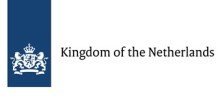
The views and opinions presented at the seminar do not necessarily reflect the views of the Embassy of the Kingdom of the Netherlands.
-
PHOTO: ANEM
-
PHOTO: ANEM
-
PHOTO: ANEM
-
PHOTO: ANEM
-
PHOTO: ANEM
-
PHOTO: ANEM
-
PHOTO: ANEM
-
PHOTO: ANEM
-
PHOTO: ANEM
-
PHOTO: ANEM
-
No comments on this topic.










